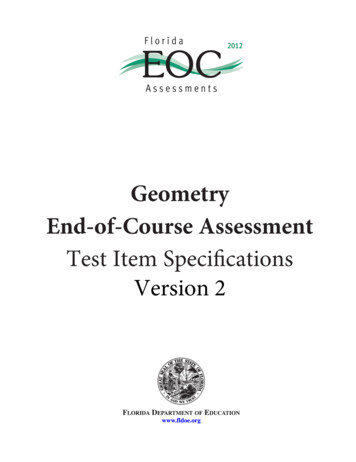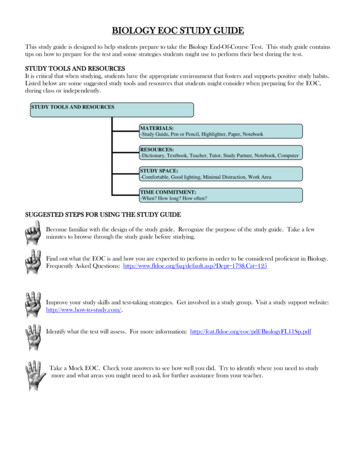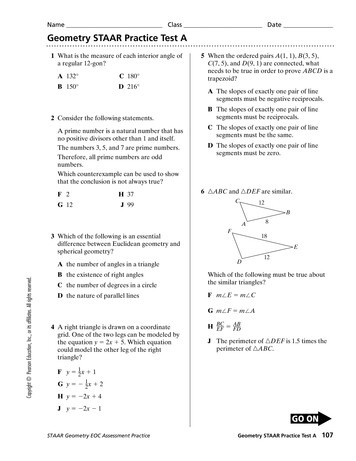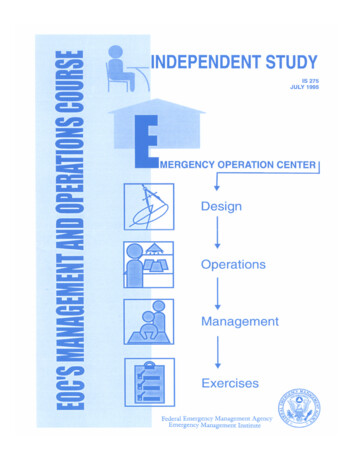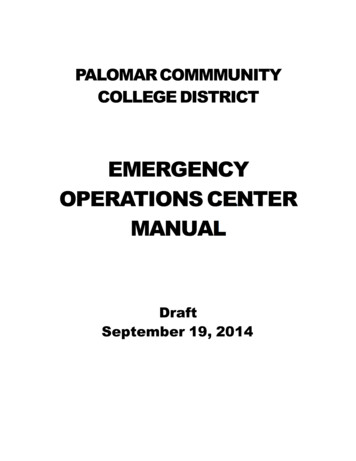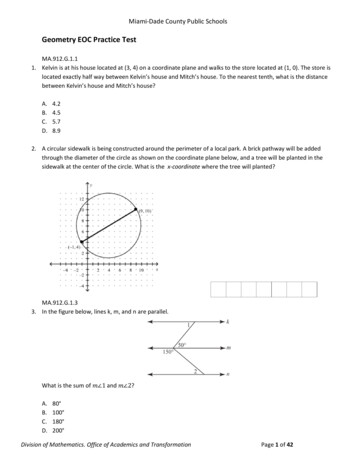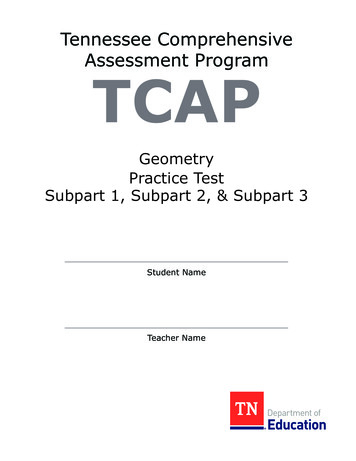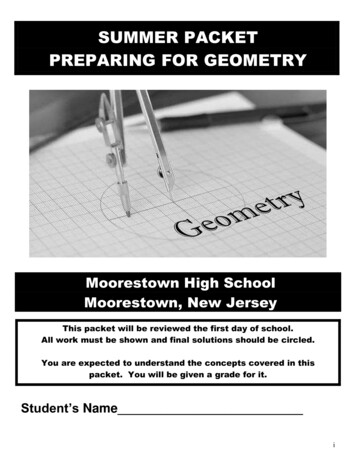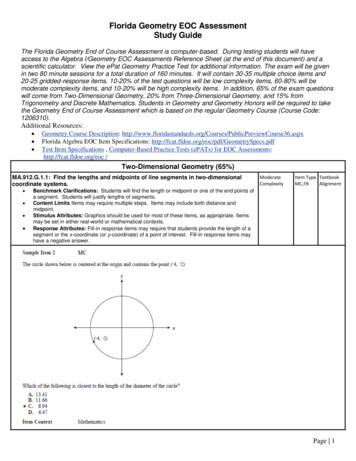
Transcription
Florida Geometry EOC AssessmentStudy GuideThe Florida Geometry End of Course Assessment is computer-based. During testing students will haveaccess to the Algebra I/Geometry EOC Assessments Reference Sheet (at the end of this document) and ascientific calculator. View the ePat Geometry Practice Test for additional information. The exam will be givenin two 80 minute sessions for a total duration of 160 minutes. It will contain 30-35 multiple choice items and20-25 gridded-response items. 10-20% of the test questions will be low complexity items, 60-80% will bemoderate complexity items, and 10-20% will be high complexity items. In addition, 65% of the exam questionswill come from Two-Dimensional Geometry, 20% from Three-Dimensional Geometry, and 15% fromTrigonometry and Discrete Mathematics. Students in Geometry and Geometry Honors will be required to takethe Geometry End of Course Assessment which is based on the regular Geometry Course (Course Code:1206310).Additional Resources: Geometry Course Description: iewCourse36.aspxFlorida Algebra EOC Item Specifications: t Item Specifications , Computer-Based Practice Tests (ePATs) for EOC Assessments:http://fcat.fldoe.org/eoc /Two-Dimensional Geometry (65%)MA.912.G.1.1: Find the lengths and midpoints of line segments in two-dimensionalcoordinate systems. ModerateComplexityItem Type TextbookMC,FRAlignmentBenchmark Clarifications: Students will find the length or midpoint or one of the end points ofa segment. Students will justify lengths of segments.Content Limits Items may require multiple steps. Items may include both distance andmidpoint.Stimulus Attributes: Graphics should be used for most of these items, as appropriate. Itemsmay be set in either real-world or mathematical contexts.Response Attributes: Fill-in response items may require that students provide the length of asegment or the x-coordinate (or y-coordinate) of a point of interest. Fill-in response items mayhave a negative answer.Page 1
MA.912.G.1.3: Identify and use the relationships between special pairs of angles formed ModerateComplexityby parallel lines and transversals. Benchmark Clarification: Students will recognize, represent, apply, and/or explainproperties of angles formed by parallel lines and transversals. Content Limits: Items may have multiple sets of parallel lines. Items will not includemore than six lines in the graphic. Stimulus Attributes: Items may be set in either real-world or mathematical contexts.Graphics should be used in these items, as appropriate. Response Attribute: Fill-in response items may require that students provide anangle measure.ItemType:MC, FRTextbookAlignment.Page 2
Examples from Standards Website:Example 1: In the diagram, the lines k and l are parallel. Find the value of x. Find all angle values in the diagram. Explain your answer.Example 2: In the diagram, the lines m and n are parallel. Find the value of x. Explain your answer.MA.912.G.2.2: Determine the measures of interior and exterior angles of polygons,justifying the method used. Benchmark Clarification: Students will determine the measures of interior and exterior anglesof polygons.Content Limit: All angle measurements will be in degrees.Stimulus Attributes: Items may be set in either real-world or mathematical contexts. Graphicsshould be used in these items, as appropriate.ModerateComplexityItemType:MC, FRTextbookAlignmentPage 3
Examples from Standards Website:Example 1: Calculate the measure of one interior angle and one exterior of a regular octagon. Explainyour method.Example 2: Suppose that you will make a picture frame like the one shown below. To make the regularhexagonal frame, you will use identical trapezoidal pieces. What are the measures of the angles of thetrapezoids? Explain your answer.MA.912.G.2.3: Use properties of congruent and similar polygons to solve mathematicalor real-world problems. Benchmark Clarification: Students will use properties of congruent and/or similar polygons tosolve problems.Content Limits: All angle measurements will be in degrees. Items may require statementsand/or justifications to complete formal and informal proofs.Stimulus Attribute: Graphics should be used in these items, as appropriate.HighComplexityItemType:MC, FRTextbookAlignmentPage 4
Example from Standards Website:Suppose a building is in the shape of a regular hexagon. The architect wants to put walkwaysas indicated. Show that the triangles formed are equal in size and shape.Page 5
Items assessing MA.912.G.2.3 also assess: MA.912.G.2.1: Identify and describe convex, concave, regular, and irregular polygons. High ComplexityExample from the Standards Website:Example 1: Draw a hexagon. Is it convex or concave? Is it regular or irregular? Explain your answers.Example 2: Define the terms convex, concave, regular and irregular polygon and draw a picture of the tern next to the definition.MA.912.G.4.1: Classify, construct, and describe triangles that are right, acute, obtuse, scalene, isosceles, equilateral, andequiangular. Moderate ComplexityTriangle Classification Game This game explores triangle geometry in a .4.2: Define, identify, and construct altitudes, medians, angle bisectors, perpendicular bisectors, orthocenter,centroid, incenter, and circumcenter. Moderate ComplexityExample from the Standards Website: Draw several triangles. Construct their angle bisectors. What do you observe from yourdrawings?MA.912.G.4.4: Use properties of congruent and similar triangles to solve problems involving lengths and areas. ModerateComplexityExample from the Standards Website: Of two similar triangles, the second has sides half the length of the first. The area of the firsttriangle is 20, What is the area of the second triangle?MA.912.G.4.5: Apply theorems involving segments divided proportionally. Moderate ComplexityExample from the Standards Website: In triangle ABC shown below,is parallel to. What is the length ofMA.912.G.2.4: Apply transformations (translations, reflections, rotations, dilations, andscale factors) to polygons. to determine congruence, similarity, and symmetry. Knowthat images formed by translations, reflections, and rotations are congruent to theoriginal shape. Create and verify tessellations of the plane using polygons. HighComplexity?Item Type TextbookMC, FRAlignmentRemarks: Physical objects, drawings, and dynamic geometry software might help studentsexplore this benchmark. Students' early work in elementary and middle school should form abase for teaching this benchmark (see MA.3.G.3.3, MA.4.G.5.2, and MA.7.G.4.2). Studentsshould explore different types of transformations and observe that some transformations(translations, reflections, and rotations) result in congruent shapes.Benchmark Clarification: Students will apply transformations to polygons to determinecongruence, similarity, and symmetry.Content Limits: Items may include using coordinate geometry to perform transformations in theplane. Items may require statements and/or justifications to determine congruence, similarity,and symmetry.Stimulus Attributes: Items may assess transformations, including translations, reflections,rotations, dilations, and scale factors. Graphics should be used for most of these items, asappropriate. Items may be set in either real-world or mathematical contexts.Response Attributes: Fill-in response items may require that students provide the length of asegment or the x-coordinate (or y-coordinate) of a point of interest. Fill-in response items mayhave a negative answer.Page 6
Page 7
Example from Standards Website:Explore regular polygons through manipulatives and/or drawing programs. Describe which of the polygons would be best fortiling a rectangular floor. Explain your reasoning.MA.912.G.2.5: Explain the derivation and apply formulas for perimeter and area ofpolygons (triangles, quadrilaterals, pentagons, etc.). Benchmark Clarification: Students will solve problems by using and/or derivingformulas for perimeter and/or area of polygons. Content Limits: Items requiring students to calculate area may require the use of theapothem. Composite figures may include circles. Stimulus Attributes: Items may be set in either mathematical or real-world contexts.Graphics should be used in most of these items, as appropriate.ModerateComplexityItem Type TextbookMC, FRAlignmentPage 8
Examples from the Standards Website:Example 1: A rectangle of area 360 square yards is ten times as long as it is wide. Find itslength and width.Example 2: Explain the derivation of the formula for the area of a triangle.Example 3: The design below is called the Ohio Star. Assuming that it measures 9 inches by 9inches, calculate the total area of all the orange patches, the total area of all the yellowpatches, and the total area of all the green patches. How much fabric of each color will youneed to cover an area that measures 72 inches by 90 inches?Items Assessing MA.912.G.2.5 also assess: MA.912.G.2.7: Determine how changes in dimensions affect the perimeter and area of common geometric figures.Moderate ComplexityExample from the Standards Website: If the lengths of each side of a trapezoid are tripled, determine the change inits area, and justify your answer.MA.912.G.3.3: Use coordinate geometry to prove properties of congruent, regular, and HighComplexitysimilar quadrilaterals. Benchmark Clarification: Students will use coordinate geometry and geometricproperties to justify measures and characteristics of congruent, regular, and similarquadrilaterals. Content Limits: Items may include statements and/or justifications to complete formaland informal proofs. Items may include the use of coordinate planes. Stimulus Attributes: Graphics should be used for most of these items, asappropriate. Items may be set in either real-world or mathematical contexts.Item Type TextbookMCAlignmentExamples from the Standards Website:Example: Given a quadrilateral with vertices (0, 0), (5/2, 5 3/2), (5, 0), (7, 7 3/3), prove that the diagonals of this quadrilateralare perpendicular.Example: Is rectangle ABCD with vertices at A(0, 0), B(4, 0), C(4, 2), D(0, 2) congruent to rectangle PQRS with vertices at P(-2,-1), Q(2, -1), R(2, 1), S(-2, 1)? Justify your answer.Page 9
MA.912.G.3.4: Prove theorems involving quadrilaterals. Benchmark Clarification: Students will use geometric properties to justify measures andcharacteristics of quadrilaterals.Content Limit: Items may require statements and/or justifications to complete formal andinformal proofs.Stimulus Attributes: Items may be set in either mathematical or real-world contexts. Graphicsshould be used in these items, as appropriate.HighComplexityItem Type TextbookMC, FRAlignmentExample from the Standards Website:Prove that the diagonals of a rectangle are congruent.Page 10
Items Assessing MA.912.G.3.4 also assess: MA.912.D.6.4: Use methods of direct and indirect proof and determine whether a short proof is logically valid.Moderate ComplexityExample from the Standards Website: If somebody argues, “If it’s Thursday, it is raining.” along with “It is raining” implies that"it is Thursday.", is this a valid or invalid argument? Explain your answer. MA.912.G.3.1: Describe, classify, and compare relationships among quadrilaterals including the square,rectangle, rhombus, parallelogram, trapezoid, and kite. Moderate ComplexityRemark: This benchmark examines properties of quadrilaterals one at a time.Example from the Standards Website: Explore a trapezoid through manipulatives, drawings and/or technology. Drawthe diagonals and determine whether they are perpendicular. Give a convincing argument that your judgment is correct.MA.912.G.3.2: Compare and contrast special quadrilaterals on the basis of their properties. Moderate ComplexityRemark: This benchmark examines properties of quadrilaterals one at a time.Example from the Standards Website: Explore a trapezoid through manipulatives, drawings and/or technology. Drawthe diagonals and determine whether they are perpendicular. Give a convincing argument that your judgment is correct.MA.912.G.8.5: Write geometric proofs, including proofs by contradiction and proofs involving coordinategeometry. Use and compare a variety of ways to present deductive proofs, such as flow charts, paragraphs,two-column, and indirect proofs. High ComplexityExamples from the Standards Website:Example 1: Prove that the sum of the measures of the interior angles of a triangle is 180 .Example 2: Prove that the perpendicular bisector of line segment AB is the set of all points equidistant from theendpoints A and B.Example 3: Prove that two lines are parallel if and only if the alternate interior angles the lines make with a transversalare equal.MA.912.G.4.6: Prove that triangles are congruent or similar and use the concept ofcorresponding parts of congruent triangles. Benchmark Clarification: Students will use geometric properties to justify measuresand characteristics of triangles. Content Limit: Items may require statements and/or justifications to complete formaland informal proofs. Stimulus Attributes: Items may be set in either real-world or mathematical contexts.Graphics should be used in these items, as appropriate.HighComplexityItem Type TextbookMCAlignmentPage 11
Example from the Standards Website: Prove that triangles ABC and APQ are similar.Items Assessing MA.912.G.4.6 also assess: MA.912.D.6.4: Use methods of direct and indirect proof and determine whether a short proof is logically valid.Moderate ComplexityExample from the Standards Website: If somebody argues, “If it’s Thursday, it is raining.” along with “It is raining”implies that "it is Thursday.", is this a valid or invalid argument? Explain your answer.MA.912.G.8.5: Write geometric proofs, including proofs by contradiction and proofs involving coordinategeometry. Use and compare a variety of ways to present deductive proofs, such as flow charts, paragraphs,two-column, and indirect proofs. High ComplexityExamples from the Standards Website:Example 1: Prove that the sum of the measures of the interior angles of a triangle is 180 .Example 2: Prove that the perpendicular bisector of line segment AB is the set of all points equidistant from theendpoints A and B.Example 3: Prove that two lines are parallel if and only if the alternate interior angles the lines make with a transversalare equal.Page 12
MA.912.G.4.7: Apply the inequality theorems: triangle inequality, inequality in onetriangle, and the Hinge theorem. Benchmark Clarification: Students will apply the inequality theorems to determinerelationships about sides and angles within a triangle and between triangles. Content Limit: Items may assess methods of proving triangles congruent. Stimulus Attributes: Items may be set in either mathematical or real-world contexts.Graphics should be used in these items, as appropriate.ModerateComplexityItem Type TextbookMCAlignmentExample from the Standards Website:Can you draw a triangle with sides of length 7 cm, 4 cm, and 15 cm? Explain your answer.Page 13
HighMA.912.G.5.4: Solve real-world problem s involving right triangles.Complexity Content Limits: Items may require students to apply the Pythagorean theorem,special right triangle relationships, and/or characteristics of triangles resulting from thealtitude of a right triangle drawn from the right angle to the hypotenuse. Items mayinclude the application of the geometric mean. Stimulus Attributes: Items assessing MA.912.G.5.2 may be set in eithermathematical or real-world contexts. All other items must be set in real-world context.Any radical expressions in the item stem must be in simplified or rationalized form.Graphics should be used in most of these items, as appropriate. Response Attributes: Any radical expressions in multiple-choice options will beprovided in simplified or rationalized form.Item Type TextbookMC, FRAlignmentExample from the Standards Website: The distance of the base of a ladder from the wall it leans against should be at least 1/3 of theladder's total length. Suppose a 12-ft ladder is placed according to these guidelines. Give the minimum distance of the base of the ladder fromthe wall. How far up the wall will the ladder reach? Explain and include a sketch in your explanation.Page 14
Items assessing MA.912.G.5.4 also assess: MA.912.G.5.1: Prove and apply the Pythagorean theorem and its converse. High ComplexityExample: Determine if the triangle with side lengths of 10, 12, and 18 is a right triangle. Justify your reasoning.MA.912.G.5.2: State and apply the relationships that exist when the altitude is drawn to the hypotenuse of aright triangle. Moderate ComplexityExample from the Standards Website: Find the value of x in the right triangle shown here. MA.912.G.5.3: Use special right triangles (30 - 60 - 90 and 45 - 45 - 90 ) to solveproblems. Moderate ComplexityExample: An isosceles right triangle has one leg 6 cm long. Find the lengths of the other two sides.MA.912.G.6.5: Solve real-world problems using measures of circumference, arc length,and areas of circles and sectors. Benchmark Clarification: Students will solve problems related to circles. Content Limits: All angle measurements will be in degrees. Items may requirestatements and/or justifications to complete formal and informal proofs. Stimulus Attributes: Items may be set in either real-world or mathematical contexts.Graphics should be used in most of these items, as appropriate.HighComplexityItem Type TextbookMC, FRAlignmentPage 15
Example from the Standards Website: Which will give you more: three 6-inch pizzas or two 8-inch pizzas? Explain your answer.Items assessing MA.912.G.6.5 also assess: MA.912.G.6.2: Define and identify: circumference, radius, diameter, arc, arc length, chord, secant, tangent andconcentric circles. Low ComplexityExample from the Standards Website: What is the angle between a tangent to a circle and the radius at the pointwhere the tangent meets the circle?MA.912.G.6.4: Determine and use measures of arcs and related angles (central, inscribed, and intersections ofsecants and tangents). Moderate ComplexityExample from the Standards Website: Find the measure of angle ABC in thediagram shown to the right.ModerateMA.912.G.6.6: Given the center and the radius, find the equation of a circle in thecoordinate plane or given the equation of a circle in center-radius form, state the center Complexityand the radius of the circle. Benchmark Clarification: Students will identify the center, radius, and/or graph of acircle given the equation of a circle, or write the equation of a circle given the center,radius, and/or graph. Content Limit: Equations of circles must be presented in center-radius form, where hand k are rational and r may be irrational. Items will not require students to manipulateequations to or from standard form. Stimulus Attributes: Items may be set in either mathematical or real-world contexts.Graphics should be used in most of these items, as appropriate.Item Type TextbookMCAlignmentPage 16
Example from the Standards Website: Find the equation of the circle with radius 10 and center (6, -3).Items assessing MA.912.G.6.6 also assess: MA.912.G.6.7: Given the equation of a circle in center-radius form or given the center and the radius of a circle,sketch the graph of the circle. Moderate ComplexityExample: Sketch the graph of the circle whose equation isMA.912.G.8.4: Make conjectures with justifications about geometric ideas. Distinguish HighComplexitybetween information that supports a conjecture and the proof of a conjecture. Benchmark Clarification: Students will provide statements and/or reasons in a formalor informal proof or distinguish between mere examples of a geometric idea and proofof that idea. Content Limits: Items must adhere to the content limits stated in other benchmarks.Items may include proofs about congruent/similar triangles and parallel lines.Item Type TextbookMCAlignmentExample from the Standards Website: Calculate the ratios of side lengths in several different-sized triangles with angles of 90 , 50 , and 40 . What do you notice about the ratios? How might you prove that your observation is true (or show that it is false)?Page 17
Three-Dimensional Geometry (20%)ModerateMA.912.G.7.1: Describe and make regular, non-regular, and oblique polyhedra, andComplexitysketch the net for a given polyhedron and vice versa. Benchmark Clarifications: Students will identify the net for a given polyhedron andvice versa. Students will identify and determine the types of faces and/or the numbersof edges, faces, and vertices of a given polyhedron or a given net. Content Limits: Items will only include: The five Platonic solids (tetrahedron, hexahedron or cube, octahedron,dodecahedron, and icosahedron); Right or oblique prisms or pyramids with up to 12 edges on the base orcomposites; Composites of the right or oblique prisms or pyramids; and Other solids with fewer than 15 faces.Items must not require use of formulas relating faces, edges, and vertices.Items may not include cones, spheres, or cylinders. Stimulus Attributes: Graphics should be used for most of these items, asappropriate. Items may be set in either real-world or mathematical contexts. Response Attribute: Fill-in response items may require that students provide thenumber of edges, faces, or vertices of a given polyhedron.Item Type TextbookMC, FRAlignmentExample from the Standards Website: Make a net for a tetrahedron out of poster board and fold it up to make thetetrahedron. Is this a regular polyhedron? Explain why or why not.Items assessing MA.912.G.7.1 also assess: MA.912.G.7.2: Describe the relationships between the faces, edges, and vertices of polyhedra. ModerateComplexityExample from Standards Website: Use manipulatives to investigate the relationships between faces, edges, andvertices of polyhedra i.e., Euler's Theorem.Page 18
MA.912.G.7.5: Explain and use formulas for lateral area, surface area, and volume ofsolids. Benchmark Clarification: Students will explain and/or apply formulas to determinesurface area, lateral area, and volume of solids. Content Limits: Solids will be limited to right prisms, right-circular cylinders, spheres,right pyramids, right-circular cones, and/or composites of these solids. Items may notinclude oblique figures. Items may ask students to apply knowledge of congruent andsimilar solids. Stimulus Attributes: Items may be set in either mathematical or real-world contexts.Graphics should be used in most of these items, as appropriate.ModerateComplexityItem Type TextbookMC, FRAlignmentPage 19
Example from the Standards Website: A gold class ring is dropped into a glass that is aright cylinder with a 6 cm diameter. The water level rises 1 mm. What is the volume of the ring?Example: Given the composite solid consisting of a hemisphere and a cone, calculate thesurface area and the volume.Items assessing MA.912.G.7.5 also assess: MA.912.G.7.4: Identify chords, tangents, radii, and great circles of spheres Low Complexity Example from Standards Website: On Earth, is the equator a great circle ? Explain your answer.MA.912.G.7.6: Identify and use properties of congruent and similar solids. Moderate ComplexityExample from Standards Website: Explain how the surface area and volume of similar cylinders are related.ModerateMA.912.G.7.7: Determine how changes in dimensions affect the surface area andComplexityvolume of common geometric solids. Benchmark Clarifications: Students will determine how changes in parameter(s)affect perimeter, area, surface area, or volume, or vice-versa. Students will determinehow changes to one parameter will change other parameters when the perimeter,area, surface area, or volume is held constant. Content Limits: One or two parameters may be changed, resulting in the change ofanother parameter. Three parameters may be changed in one item only if all three arechanged by a constant factor. Solids will be limited to right prisms, right circularcylinders, spheres, right pyramids, right circular cones, and/or composites of thesesolids. Items may not include oblique figures. Items may involve, explicitly and/orimplicitly, no more than four parameters. Changes in dimension may or may not resultin similar figures. Stimulus Attributes: Items may be set in either mathematical or real-world contexts.Graphics should be used in most of these items, as appropriate.Item Type TextbookMC, FRAlignmentExample from the Standards Website: Explain how changing the radius or height of a cylinder affects its surface area andvolume.Page 20
Items assessing MA.912.G.7.7 also assess: MA.912.G.2.7: Determine how changes in dimensions affect the perimeter and area of common geometricfigures. Moderate ComplexityExample from the Standards Website: If the lengths of each side of a trapezoid are tripled, determine the change inits area, and justify your answer.Trigonometry and Discrete Mathematics (15%)MA.912.T.2.1: Define and use the trigonometric ratios (sine, cosine, tangent, cotangent, ModerateComplexitysecant, cosecant) in terms of angles of right triangles. Benchmark Clarification: Students will solve real-world problems involving righttriangle trigonometry. Content Limits: Items should not include special right triangles (30 -60 -90 and 45 45 -90 ) or the Pythagorean theorem. Angle measures will be in degree measure.Items will assess only sine, cosine, and tangent to determine the length of a side or anangle measure. Stimulus Attributes: Items may be set in either real-world or mathematical contexts.Graphics should be used in all items. Response Attributes: Fill-in response items may require the student to provide anangle measure or a length. Radian equivalents of correct answers will not be used asdistractors. Fill-in response items will specify the nature of the response, if theresponse is not an integer.Item Type TextbookMC, FRAlignmentPage 21
Example: In triangle ABC, tan A 1/5. Find sin A and cot A. Example: Show that the slope of a line at 135º to the x-axis is thesame as the tangent of 135º.MA.912.D.6.2: Find the converse, inverse, and contrapositive of a statement. Benchmark Clarification: Students will identify the converse, inverse, orcontrapositive of a given statement. Content Limits: Truth tables or validity of a given statement will not be assessed.Items must present propositions as a sentence, and not by using symbols,e.g., p q or 3x 1 7 x 2. Stimulus Attribute: Items may be set in either real-world or mathematical contexts.ModerateComplexityItem Type TextbookMCAlignmentExample from the Standards Website: Determine the inverse, converse and contrapositive of the statement, “If it is Thursday,there will be rain.”Items assessing MA.912.D.6.2 also assess: MA.912.D.6.3: Determine whether two propositions are logically equivalent. Moderate ComplexityExample from the Standards Website: Determine whether the propositionsandare logicallyequivalent.Page 22
Benchmarks that are not assessed by the End-of-Course : Analyze the structure of Euclidean geometry as an axiomatic system.Distinguish between undefined terms, definitions, postulates, and theorems.HighNotassessedMA.912.G.8.2: Use a variety of problem-solving strategies, such as drawing a diagram,making a chart, guess-and-check, solving a simpler problem, writing an equation, andworking backwards.ModerateNotassessedMA.912.G.8.3: Determine whether a solution is reasonable in the context of the originalsituation.ModerateNotassessedMA.912.G.8.6: Perform basic constructions using straightedge and compass, and/ordrawing programs describing and justifying the procedures used. Distinguish betweensketching, constructing, and drawing geometric figures.HighNotassessedMA.912.G.1.2: Construct congruent segments and angles, angle bisectors, and paralleland perpendicular lines using a straight edge and compass or a drawing program,explaining and justifying the process used.MA.912.G.4.3: Construct triangles congruent to given triangles.The next two pages contain a copy of the Algebra I / Geometry EOC Assessment Reference Sheet which maybe used on this exam. Not all references found on the sheet will be used on this exam.A link to this reference sheet m%20EOC%20Ref%20Sheet%20.pdfPage 23
Page 24
Page 25
moderate complexity items, and 10-20% will be high complexity items. In addition, 65% of the exam questions will come from Two-Dimensional Geometry, 20% from Three-Dimensional Geometry, and 15% from Trigonometry and Discrete Mathematics. Students in Geometry and Geometry Honors will be required to take
